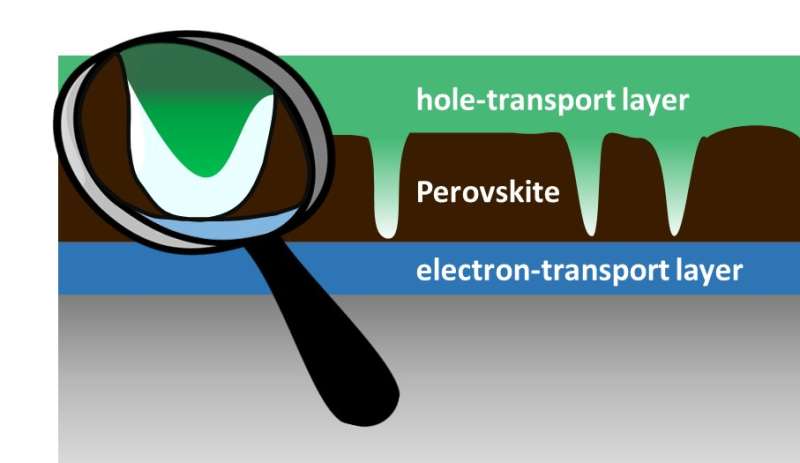Perovskite solar cells: Perfection not required

Metal-organic perovskite layers for solar cells are often fabricated using the spin-coating technique on compact substrates. These perovskite layers generally exhibit holes, yet attain astonishingly high levels of efficiency. The reason that these holes do not cause significant short circuits between the front and back contact has now been discovered by a HZB team headed by Dr.-Ing. Marcus Baer in cooperation with the group headed by Professor Henry Snaith (Oxford University) at BESSY II.
The early metal-organic perovskites exhibited efficiency levels of only a few percent (2.2 percent in 2006). That changed quickly, however. The record level now lies considerably above 22 percent. The equivalent efficiency increase in commercially dominant silicon solar cell technology took more than 50 years. Additionally, thin films made of low-cost metal-organic perovskites can be produced on a large scale, for example, by spin coating and baking (whereby the solvent evaporates and the material crystallizes).
Nevertheless, the thin perovskite film that results from spin coating on compact substrates is generally not perfect, but instead exhibits many holes. The problem is that these holes could lead to short circuits in the solar cell by the adjacent layers of the solar cell coming into contact. This would reduce the efficiency level considerably. However, such a reduction is not observed.
Now, Marcus Bär and his group, together with the Spectro-Microscopy group of the Fritz Haber Institute, have carefully examined samples from Henry Snaith. Using scanning electron microscopy, they mapped the surface morphology. They subsequently analysed the sample areas exhibiting holes for their chemical composition using spectromicrographic methods at BESSY II. "We were able to show that the substrate was not really exposed, even in the holes, but instead, a thin layer is built up, essentially as a result of the deposition and crystallization processes, that apparently prevents short circuits," explains doctoral student Claudia Hartmann.
The scientists were also able to ascertain that the energy barrier the charge carriers had to overcome in order to recombine with one another in the event of a direct encounter of the contact layers is relatively high. "The electron transport layer (TiO2) and the transport material for positive charge carriers (Spiro MeOTAD) do not actually come into direct contact. In addition, the recombination barrier between the contact layers is sufficiently high that the losses in these solar cells is minute despite the many holes in the perovskite thin-film," says Bär.
The study is published in Advanced Materials Interfaces.
More information: Claudia Hartmann et al, Spatially Resolved Insight into the Chemical and Electronic Structure of Solution-Processed Perovskites-Why to (Not) Worry about Pinholes, Advanced Materials Interfaces (2018). DOI: 10.1002/admi.201701420
Provided by Helmholtz Association of German Research Centres



















